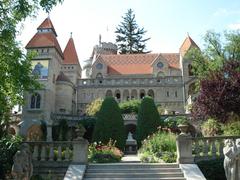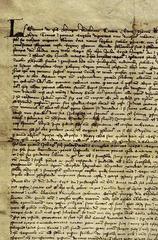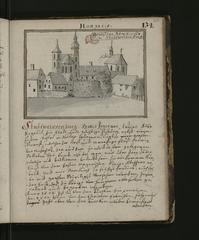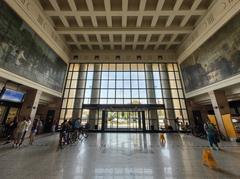
Serbian Orthodox Church in Székesfehérvár: Visiting Hours, Tickets, and Historical Significance
Date: 04/07/2025
Introduction
Set in the historic Rácváros (Serbian Town) district of Székesfehérvár, Hungary, the Serbian Orthodox Church of St. John the Baptist is a testament to the enduring cultural, spiritual, and artistic legacy of the Serbian community in Central Europe. Erected between 1770 and 1780 atop an earlier wooden church built by 17th-century Serbian settlers fleeing Ottoman persecution, this Baroque edifice reflects centuries of religious devotion and cross-cultural exchange between Eastern Orthodox and Western European traditions (mycityhunt.ie; mycityquest.com).
This guide provides a comprehensive overview of the church’s history, architectural features, cultural significance, and practical information for visitors—including up-to-date details on opening hours, admission, accessibility, and guided tours. Whether you are a traveler, a student of history, or a spiritual seeker, the Serbian Orthodox Church in Székesfehérvár offers a unique window into the multicultural heritage of Hungary.
Historical Background
Serbian Settlement and the Birth of Rácváros
The roots of Székesfehérvár’s Serbian Orthodox community trace back to the 16th and 17th centuries, when waves of Serbian refugees (known locally as “rácok”) settled in Hungary to escape Ottoman rule. In Székesfehérvár, these settlers established the Rácváros district, building their original church from simple materials as a symbol of faith and resilience (mycityhunt.ie; diplomacyandcommerce.rs).
Construction of the Baroque Church
As the community prospered, the need for a permanent sanctuary led to the construction of the current Baroque church between 1770 and 1780. Master mason Joseph Kershoffer oversaw its construction, ingeniously building over the old wooden church so that worship could continue uninterrupted. The church’s main structure was completed by 1771, with interior decorations finalized by 1780 (mycityhunt.ie).
Architectural and Artistic Highlights
Exterior Features
The church’s Baroque façade is characterized by pilasters and lesenes, while semicircular niches above the entrance and on the southern wall hold remnants of original frescoes. The western bell tower, designed in the style of Austrian architect Lorenz Landner, distinguishes it from traditional Byzantine Orthodox churches and reflects 18th-century Habsburg influences (Wikipedia; Academia.edu).
Interior and Iconostasis
Inside, visitors are greeted by a single nave topped with domes and semi-domes, adorned with folk Byzantine-style frescoes painted between 1772 and 1774. These frescoes depict scenes from the lives of Christ and St. John the Baptist, enveloping the space in spiritual and artistic vibrancy (mycityhunt.ie).
The Rococo iconostasis, carved by Ferenc Horváth and József Fijercskó and painted in 1776 by Jovan Grabován and Grigorije Popovity, stands as the church’s crowning masterpiece. Its intricate gilded structure and iconography represent a rare fusion of Eastern Orthodox and Western Rococo styles, unique within Hungary (Wikipedia).
Notable Artifacts
- Bell Tower: Houses a 19th-century bell weighing about 300 kilograms, known for its distinct tone.
- Vladimir Mother of God Icon: A 15th-century icon believed to have accompanied the earliest Serbian settlers.
- Katarina Ivanović Paintings: Permanent exhibition showcasing the works of the first female Serbian artist illustrating diaspora life (Wikipedia).
Religious and Cultural Life
The church remains an active center of worship, upholding the sacraments, icon veneration, and liturgical traditions of the Serbian Orthodox faith (westernchurch.net). Major feast days, such as the celebration of St. John the Baptist, are marked with special liturgies, processions, and community gatherings that often include traditional Serbian music and cuisine.
The adjacent Rácváros Open-Air Museum (skanzen) documents the local Serbian community’s history, showcasing folk crafts and architecture. The church and museum together earned Székesfehérvár the Europa Nostra Award for heritage conservation in 1989 (turizmus.szekesfehervar.hu).
Visitor Information
Visiting Hours
- Typical Opening: Tuesday–Sunday, 10:00 AM–5:00 PM (closed Mondays and major holidays). Confirm current hours on the official tourism website or by contacting the church directly, as times may vary for services or special events (turizmus.szekesfehervar.hu).
Admission and Tickets
- Entrance: Free (donations appreciated). Guided tours, which provide deeper historical and cultural context, may require prior booking and a small fee.
Accessibility
- Physical Access: Ramp at the main entrance; some interior areas may have limited accessibility due to the historic structure.
- Language: Services are held in Serbian, but staff and guides may communicate in Hungarian or English.
Visitor Etiquette
- Dress Code: Modest attire recommended (shoulders and knees covered; men remove hats).
- Photography: Permitted outside of services with permission; no flash photography during liturgies.
- Worship Participation: All are welcome to observe services; Holy Communion is reserved for Orthodox Christians.
Travel Tips and Nearby Attractions
- Location: Rácváros district, easily reached by foot, public transport, or taxi from Székesfehérvár’s city center. Parking is available nearby, though limited during peak periods (wildtrips.net).
- Other Attractions: Close to the Székesfehérvár Cathedral, Bory Castle, the King Stephen Museum, and the downtown shopping and café district.
- Best Time to Visit: April–October for pleasant weather and cultural events.
Frequently Asked Questions (FAQ)
Q: What are the visiting hours of the Serbian Orthodox Church in Székesfehérvár?
A: Typically, Tuesday–Sunday, 10:00 AM–5:00 PM; closed Mondays and major holidays. Always verify before visiting.
Q: Is there an entrance fee?
A: No, entrance is free; donations are encouraged.
Q: Is the church accessible for visitors with disabilities?
A: The main entrance is ramped, but some areas may be difficult to access.
Q: Can visitors take photographs?
A: Yes, outside of service times and with staff permission; avoid using flash.
Q: Are guided tours available?
A: Yes, by prior arrangement; check with the church or local tourism offices.
Q: What language are services conducted in?
A: Primarily Serbian; some guides may speak Hungarian or English.
Conclusion and Recommendations
The Serbian Orthodox Church in Székesfehérvár is more than an architectural jewel; it is a vibrant center of faith, heritage, and cultural dialogue. Its Baroque and Byzantine artistic treasures, ongoing religious life, and role in the preservation of Serbian traditions in Hungary make it an essential destination for any visitor interested in the region’s rich history.
To make the most of your visit:
- Verify opening hours and event schedules in advance.
- Consider joining a guided tour for deeper insight.
- Explore the neighboring Rácváros Open-Air Museum for a fuller understanding of local heritage.
- Dress modestly and respect church customs.
- Download the Audiala app for up-to-date information, tour bookings, and cultural tips.
Visiting this church offers a unique opportunity to engage with Székesfehérvár’s multicultural past and present, making it a memorable highlight of your journey through Hungary.
References and Further Reading
- mycityhunt.ie
- mycityquest.com
- Wikipedia
- Academia.edu
- westernchurch.net
- turizmus.szekesfehervar.hu
- wildtrips.net
- audiala.com






